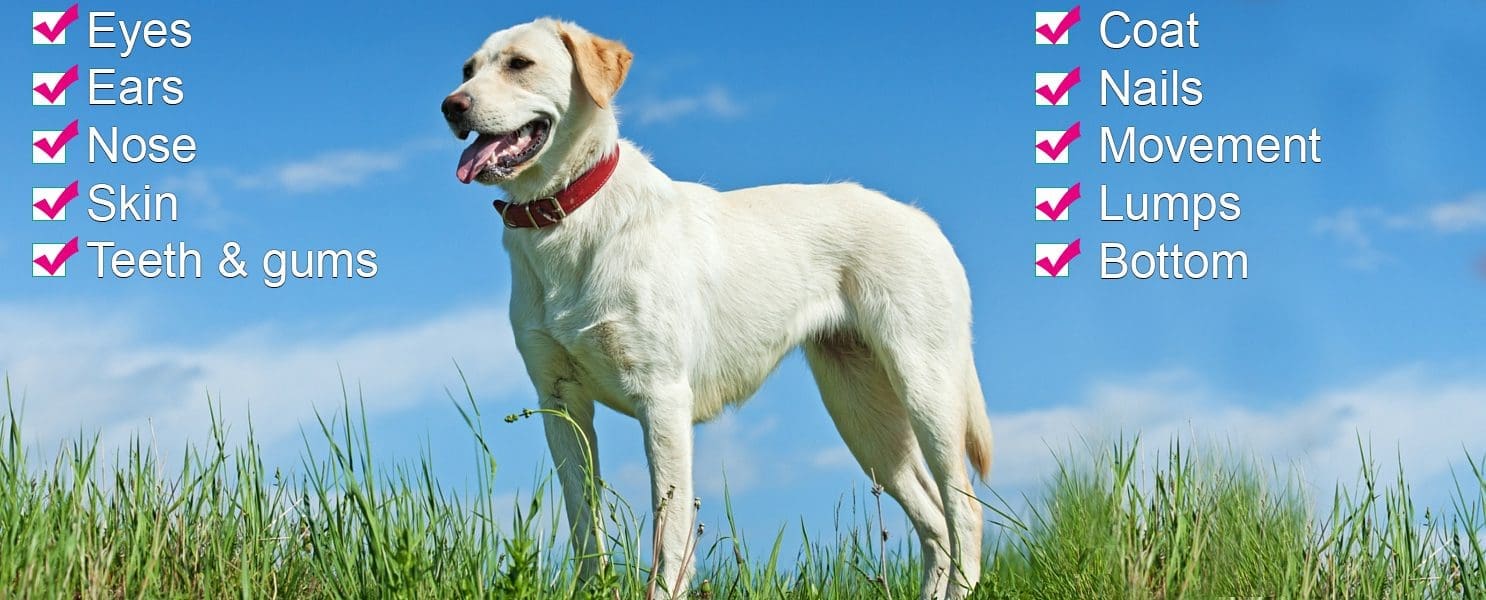Be your dog’s best friend and get to know your dog by doing simple, weekly health checks at home.
Your dog can’t tell you if something is wrong so it’s up to you to find out. As a responsible dog owner, it’s a good idea to have a health check list of things to look out for on a regular basis. This way you’ll learn what is normal for your dog and be quickly alerted to any change. If you spot anything of concern you can make an appointment with your vet promptly, meaning there is more chance that any health problems can be caught early. If you have a new puppy, get him or her used to being examined straight away. Do everything gently and reward your dog appropriately.

Look and feel your dog’s nose – Is your dog’s nose cold and wet? If your dog’s nose is warm or a bit dry, but everything else seems fine and he is eating and drinking normally, you don’t need to worry. Check your dog’s nose for any soreness or discharge.
Look at your dog’s eyes – the eyes should be bright. A certain amount of discharge due to a normal amount of tears, will result in a blackish residue building up in the corner of the eye. This is normal for most dogs. If you notice any of the following, you should take your dog to the vet;
Look and smell inside both ears – learn what is normal for your dog. Floppy ears or hairy ears can hide problems. Hair in itself is not necessarily a problem and sometimes plucking it out can lead to inflammation so get advice from your vet. A small amount of wax can be normal and protective but excess quantities can lead to scratching and infection. Get veterinary advice if you find:
The vet will often prescribe drops for your dog. In some cases, they will want you to clean your dog’s ears as a routine to prevent problems from recurring. It is very important to only do this with veterinary instruction.
Teeth and gums – do try to examine your dog’s teeth and gums regularly but be careful when doing so, some dogs will just not allow it! In most cases you only need to raise/lower the lips to check the teeth. You should be looking for:
Your vet/veterinary nurse will be only too happy to give you advice on how to look after your dog’s teeth at home, and what diets may help with those that won’t tolerate the toothbrush!
Your dog’s skin – you can use your eyes and your hands to examine the skin all over the body. Firstly, note whether your dog is biting/chewing or scratching their skin, and whether there are any obvious changes in the coat. Look in all the hidden places like under the front legs and between the pads. Don’t forget to look for evidence of fleas, even if you treat regularly for them. Flea droppings look like bits of black soot. Rashes are not uncommon and may appear like red rings or spots. Whilst examining the skin you may also come across lumps and bumps. Always seek your vet’s advice for this.
Nails – don’t forget to look at your dog’s nails. In long-haired dogs especially it is important to check the dew claws as they can grow right round and become embedded in the pad. The length of nails often worries owners who are reluctant to clip them themselves for fear of making them bleed.
Bottom – finish your check up by having a quick look under your dog’s tail. Anal glands are scent glands which are just inside the bottom. They can get impacted or infected and can cause pain and irritation if they do. Normally you won’t see anything, but if there is swelling or redness to either side of the anus, you should get your vet to check it out. If your dog drags his back end across the floor, this is usually because of full anal glands and not because he has worms.
Weight – keep any eye on your dog’s weight. Being overweight can put extra strain on your dog’s joints so keeping his/her weight down is helpful. If your dog is overweight, ask your vet for help in planning a weight reduction programme.
Movement –Regular exercise can help your dog “walk off” any excess food and helps prevent joints from stiffening up. It helps maintain mobility so that your dog can remain active. Learn to recognise how your dog moves. Dogs with poor joints should avoid very energetic exercise. Some dogs especially in their later years suffer from arthritis which can be very painful. Your vet can recommend treatment such as the use of joint supplements or non-steroidal anti-inflammatory drugs.
Why not book to attend one of our First Aid for Dogs courses to learn more about this and helping your dog in an emergency situation.
Our Dog First Aid courses are the only ones in the UK to be regulated by SQA Accreditation, unlike some courses being run in the local area who are advertising their courses are accredited. This means that anyone completing one of our Canine First Aid courses will now not only receive a certificate via our Awarding Body, ITC First, but will also attain a nationally recognised qualification.
Our next courses are running in Banchory on Sunday 15th September 2019, with the options of both a 3 hour course and a 6 hour course. Both courses are suited to pet owners, dog walkers, groomers and kennel owners.